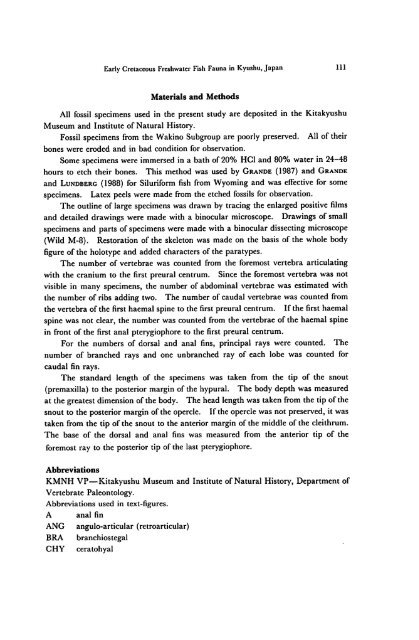Early Cretaceous Freshwater Fish Fauna in Kyushu, Japan
Early Cretaceous Freshwater Fish Fauna in Kyushu, Japan
Early Cretaceous Freshwater Fish Fauna in Kyushu, Japan
Create successful ePaper yourself
Turn your PDF publications into a flip-book with our unique Google optimized e-Paper software.
<strong>Early</strong> <strong>Cretaceous</strong> <strong>Freshwater</strong> <strong>Fish</strong> <strong>Fauna</strong> <strong>in</strong> <strong>Kyushu</strong>, <strong>Japan</strong> 111<br />
Materials and Methods<br />
All fossil specimens used <strong>in</strong> the present study are deposited <strong>in</strong> the Kitakyushu<br />
Museum and Institute of Natural History.<br />
Fossil specimens from the Wak<strong>in</strong>o Subgroup are poorly preserved. All of their<br />
bones were eroded and <strong>in</strong> bad condition for observation.<br />
Some specimens were immersed <strong>in</strong> a bath of 20% HC1 and 80% water <strong>in</strong> 24-48<br />
hours to etch their bones. This method was used by Grande (1987) and Grande<br />
and Lundberg (1988) for Siluriform fish from Wyom<strong>in</strong>g and was effective for some<br />
specimens. Latex peels were made from the etched fossils for observation.<br />
The outl<strong>in</strong>e of large specimens was drawn by trac<strong>in</strong>g the enlarged positive films<br />
and detailed draw<strong>in</strong>gs were made with a b<strong>in</strong>ocular microscope. Draw<strong>in</strong>gs of small<br />
specimens and parts of specimens were made with a b<strong>in</strong>oculardissect<strong>in</strong>g microscope<br />
(Wild M-8). Restoration of the skeleton was made on the basis of the whole body<br />
figure of the holotype and added characters of the paratypes.<br />
The number of vertebrae was counted from the foremost vertebra articulat<strong>in</strong>g<br />
with the cranium to the first preural centrum. S<strong>in</strong>ce the foremost vertebra was not<br />
visible <strong>in</strong> many specimens, the number of abdom<strong>in</strong>al vertebrae was estimated with<br />
the number of ribs add<strong>in</strong>g two. The number of caudal vertebrae was counted from<br />
the vertebra of the first haemal sp<strong>in</strong>e to the first preural centrum. If the first haemal<br />
sp<strong>in</strong>e was not clear, the number was counted from the vertebrae of the haemal sp<strong>in</strong>e<br />
<strong>in</strong> front of the first anal pterygiophore to the first preural centrum.<br />
For the numbers of dorsal and anal f<strong>in</strong>s, pr<strong>in</strong>cipal rays were counted. The<br />
number of branched rays and one unbranched ray of each lobe was counted for<br />
caudal f<strong>in</strong> rays.<br />
The standard length of the specimens was taken from the tip of the snout<br />
(premaxilla) to the posterior marg<strong>in</strong> of the hypural. The body depth was measured<br />
at the greatest dimension of the body. The head length was taken from the tip of the<br />
snout to the posterior marg<strong>in</strong> of the opercle. If the opercle was not preserved,it was<br />
taken from the tip of the snout to the anterior marg<strong>in</strong> of the middle of the cleithrum.<br />
The base of the dorsal and anal f<strong>in</strong>s was measured from the anterior tip of the<br />
foremost ray to the posterior tip of the last pterygiophore.<br />
Abbreviations<br />
KMNH VP—Kitakyushu Museum and Institute of Natural History, Department of<br />
Vertebrate Paleontology.<br />
Abbreviations used <strong>in</strong> text-figures.<br />
A<br />
ANG<br />
BRA<br />
CHY<br />
anal f<strong>in</strong><br />
angulo-articular (retroarticular)<br />
branchiostegal<br />
ceratohyal

















